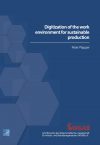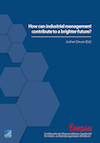Search


Bibtex
Cite as text
@Inbook{Stern+Freitag,
Cite-key = "Stern2022wgab",
Year= "2022",
Volume= "Schriftenreihe der Wissenschaftlichen Gesellschaft für Arbeits- und Betriebsorganisation (WGAB) e. V.",
Pages= "97-113",
Journal = "WGAB",
Title= "Human-Centered Design of Hybrid Cyber-Physical Production Systems – Use of Human Autonomy Teaming as a Future Way of Working",
Author= "Hendrik Stern1, Michael Freitag1,2
1Universität Bremen, Fachbereich Produktionstechnik
2BIBA - Bremer Institut für Produktion und Logistik an der Universität Bremen
",
Doi= "https://doi.org/10.30844/WGAB_2022_6",
Abstract= "Many production processes are changing towards hybrid CPPS, in which humans work together with intelligent as well as automated or autonomously acting systems. This enables economic advantages through more efficient processes, error reduction, and quality improvements. It further contributes to a sustainable production, which preserves resources and enhances operators' well-being. To achieve these advantages, an adequate system design is required. Here, various design approaches are available, such as the creation of active involvement of people and adequate situational awareness, and the consideration of both operators and automation as equal and independent actors.
But how do they affect its performance and the operators in detail to achieve both economic and human-centered goals? We present the results of a first literature review on the interaction of humans and autonomous systems in production systems and the associated allocation of work (Human Autonomy Teaming, HAT) and open research problems, respectively. Finally, we propose and discuss preliminary ideas and starting points to solve these design issues as a basis for future research work.
",
Keywords= "Human Autonomy Teaming, Cyber-Physical Production Systems, Human-Machine-Interaction, Human-Centered Design, Industry 5.0",
}
Hendrik Stern1, Michael Freitag1,2
1Universität Bremen, Fachbereich Produktionstechnik
2BIBA - Bremer Institut für Produktion und Logistik an der Universität Bremen(2022): Human-Centered Design of Hybrid Cyber-Physical Production Systems – Use of Human Autonomy Teaming as a Future Way of Working. Schriftenreihe der Wissenschaftlichen Gesellschaft für Arbeits- und Betriebsorganisation (WGAB) e. V.(2022), S. 97-113. Online: https://doi.org/10.30844/WGAB_2022_6 (Abgerufen 27.07.24)
Open Access
Abstract
Abstract
Many production processes are changing towards hybrid CPPS, in which humans work together with intelligent as well as automated or autonomously acting systems. This enables economic advantages through more efficient processes, error reduction, and quality improvements. It further contributes to a sustainable production, which preserves resources and enhances operators' well-being. To achieve these advantages, an adequate system design is required. Here, various design approaches are available, such as the creation of active involvement of people and adequate situational awareness, and the consideration of both operators and automation as equal and independent actors. But how do they affect its performance and the operators in detail to achieve both economic and human-centered goals? We present the results of a first literature review on the interaction of humans and autonomous systems in production systems and the associated allocation of work (Human Autonomy Teaming, HAT) and open research problems, respectively. Finally, we propose and discuss preliminary ideas and starting points to solve these design issues as a basis for future research work.
Keywords
Schlüsselwörter
Human Autonomy Teaming, Cyber-Physical Production Systems, Human-Machine-Interaction, Human-Centered Design, Industry 5.0

 English
English
